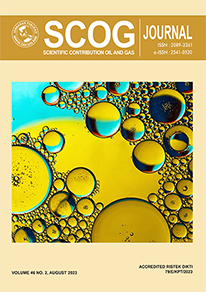Initial Analysis of The Characteristics of Sweet Orange (Citrus Sinensis) Peel Essential Oils as an Alternative Surfactant in The Tertiary Oil Recovery Method
DOI:
https://doi.org/10.29017/SCOG.46.2.1562Keywords:
biosurfactant, MES, Enhanced Oil Recovery, citrus sinensisAbstract
Surfactant flooding is one of the types of EOR that reduces the surface tension between two immiscible fluids. The essential oil of sweet orange peel (citrus sinensis) contains a methyl ester group found in the pectin of sweet orange peel, so it has the potential as a raw material for making Methyl Ester Sulfonate by transesterification and sulfonation processes using H2SO4 reactants. This research is focused on testing the MES characteristics of the essential oil of orange peel in the form of density, viscosity, pH, acid number, and compatibility tests. The results of testing the characteristics of the essential oil of sweet orange peel obtained a density of 0.9 g/cm3, a viscosity of 1.36 cP, a neutral pH of 7, and an acid number of 3.048%, so based on these characteristic values the MES of the essential oil of orange peel was included in the initial screening. Alternative MES. Based on the surfactant compatibility test with a concentration scenario of 0.1%, 0.3%, 0.5%, 0.7%, and 1% in brine with a salinity of 15,000 ppm, the best is the 0.1% surfactant scenario. However, all scenarios qualify for compatibility. Certain surfactant solutions are not clear or cloudy, but that does not mean they cannot be injectedReferences
M. K. Anam, S. Purwanto and Supranto, "Modifikasi Sodium Lignosulfonat Melalui Epoksidasi Minyak Biji Kapuk dan Penambahan Kosurfaktan," Jurnal Rekayasa Proses, 2015.
Z. Li, Y. Lu, H. Wu, M. Yang, H. Feng, D. Xu, and J. Hou, "A Novel Ultra-Low IFT Spontaneous Emulsification System for Enhanced Oil Recovery in Low Permeability Reservoir," Society of Petroleum Engineers, pp. 1-12, 2018.
O. ElMofty, Surfactant Enhanced Oil Recovery by Wettability Alteration in Sandstone Reservoir, Missouri University of Science and Technology, 2012.
A. O. Gbadamosi, R. Junin, M. A. Manan, A. Agi, and A. S. Yusuff, "An Overview of Chemical Enhanced Oil Recovery: Recent Advances and Prospects," International Nano Letters, pp. 171-202, 2019.
N. Hope and A. Gideon, "Biosurfactant Production from Palm Oil Mill Effluent (POME) for Applications as Oil Field Chemical in Nigeria," Society of Petroleum Engineers, pp. 1-19, 2015.
I. Nowrouzi, A. H. Mohammadi and A. K. Manshad, "Water-oil Interfacial Tension (IFT) Reduction and Wettability Alteration in Surfactant Flooding Process Using Extracted Saponin from Anabasis Setifera Plant," Elsevier, pp. 1-49, 2019.
I. F. Nata, Y. N. Ma'rifah and Herlina, "Minyak Kulit Jeruk Pakis Sebagai Essential Oil dalam Pembuatan Sabun: Ekstraksi dan Karakterisasi," pp. 30-36, 2014.
J. J. Sheng, Modern Chemical Enhanced Oil Recovery, United Kingdom: Elsevier, 2011.
F. Hanum, M. A. Tarigan and I. M. Deviliany, "Ekstraksi Pektin dari Kulit Buah Pisang Kepok (Musa paradisiaca)," Jurnal Teknik Kimia USU, pp. 49-53, 2012.
A. Nugroho and L. Buchori, "Sintesa Metil Ester Sulfonat dari Minyak Jathropa Curcas dan Aplikasinya pada Proses Enhanced Oil Recovery," Metana, vol. 15, pp. 19-24, 2019.
D. Supriningsih, Pembuatan Metil Ester Sulfonat (MES) Sebagai Surfaktan untuk Enhanced Oil Recovery (EOR), Depok: Universitas Indonesia, 2010.
I. F. Nata, Y. N. Ma'rifah and Herlina, "Minyak Kulit Jeruk Pakis Sebagai Essential Oil Dalam Pembuatan Sabun : Ekstraksi Dan Karakterisasi," vol. 3 , pp. 30-36, 2014.
M. Chasani, V. H. Nursalim, S. Widyaningsih, I. N. Budiasih and W. A. Kurniawan, "Sintetis, Pemurnian dan Karakterisasi Metil Ester Sulfonate (MES) Sebagai Bahan Inti Deterjen dari Minyak Biji Nyamplung (Calophyllum inophyllum L)," pp. 63-72, 2014.
H. Eni, K. Sutriah and S. Muljani, "Surfaktan Berbasis Minyak Sawit Untuk Aplikasi EOR Pada Lapangan Minyak Intermediet," Lembaran Publikasi Minyak dan Gas Bumi, vol. 51, pp. 13-21, 2017.
T. Bantacut and W. Darmanto, "Sifat Korosif Surfaktan MES (Metil Ester Sulfonat) dari Minyak Sawit dalam Pemilihan Bahan Surface Facilities untuk Aplikasi EOR (Enhanced Oil Recovery)," Jurnal Teknologi Industri Pertanian, pp. 105-113, 2014.
N. Iman, A. R. R and Nurhaeni, "Sintesis Surfaktan Metil Ester Sulfonat (MES) dari Metil Laurat," KOVALEN, pp. 54-66, 2016.
E. Hambali, A. Suryani and M. Rivai, "Proses Pengembangan Teknologi Surfaktan MES Dari Metil Ester Minyak Sawit Untuk Aplikasi EOR/IOR: Dari Skala Lab Ke Skala Pilot," Konferensi Nasional "Inovasi dan Technopreneurship" IPB International Convention Center, Bogor, 18-19 Februari 2013, pp. 1-6, 2013.
S. Hidayati, A. S. Zuidar and F. Yanto, "Optimasi Proses Pembuatan Metil Ester Sulfonat (MES) dari Minyak Jarak Pagar (Jatropha Curcas L) dan Pengaruhnya Terhadap Nilai Tegangan Antarmuka Menggunakan Metode Permukaan Respon," pp. 160-172, 2009.
A. H. Syed, A. K. Idris, D. F. Mohshim, N. Yekeen, and M. A. Buriro, "Influence of Lauryl Betaine on Aqueous Solution Stability, Foamibility, and Foam Stability," Journal of Petroleum Exploration and Production Technology, pp. 2659-2665, 2019.
Muhpidah, E. Hambali, A. Suryani and I. A. Kartika, "Palm Oil Anionic Surfactants Based Emulsion Breaker (Case Study of Emulsion Breaker at Semanggi Field Production Wells)," IOP, pp. 1-9, 2017.
S. Sugihardjo and H. Eni, “Substitution of Petroleum Base With Mes Base Surfactant for Eor: Laboratory Screening,†Sci. Contrib. Oil Gas, vol. 37, no. 1, pp. 35–44, 2022, doi: 10.29017/scog.37.1.622.
Downloads
Published
Issue
Section
License
Copyright (c) 2023 © Copyright by Authors. Published by LEMIGAS

This work is licensed under a Creative Commons Attribution 4.0 International License.
Authors are free to Share — copy and redistribute the material in any medium or format for any purpose, even commercially Adapt — remix, transform, and build upon the material for any purpose, even commercially.
The licensor cannot revoke these freedoms as long as you follow the license terms, under the following terms Attribution — You must give appropriate credit , provide a link to the license, and indicate if changes were made . You may do so in any reasonable manner, but not in any way that suggests the licensor endorses you or your use.
No additional restrictions — You may not apply legal terms or technological measures that legally restrict others from doing anything the license permits.














